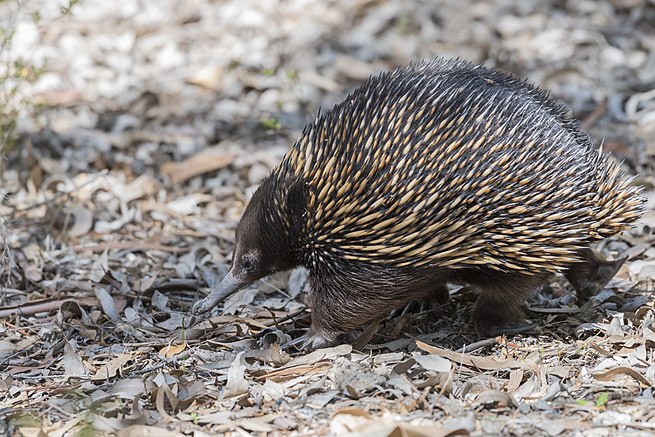Main Difference
The main difference between Echidna and Hedgehog is that the Echidna is a family of mammals and Hedgehog is a small spiny mammal.
-
Echidna
Echidnas (), sometimes known as spiny anteaters, belong to the family Tachyglossidae in the monotreme order of egg-laying mammals. The four extant species of Echidnas and the platypus are the only living mammals that lay eggs and the only surviving members of the order Monotremata. The diet of some species consists of ants and termites, but they are not closely related to the true anteaters of the Americas, which are xenarthrans, along with sloths and armadillos. Echidnas live in Australia and New Guinea.
Echidnas evolved between 20 and 50 million years ago, descending from a platypus-like monotreme. This ancestor was aquatic, but echidnas adapted to life on land.
-
Hedgehog
A hedgehog is any of the spiny mammals of the subfamily Erinaceinae, in the eulipotyphlan family Erinaceidae. There are seventeen species of hedgehog in five genera, found through parts of Europe, Asia, and Africa, and in New Zealand by introduction. There are no hedgehogs native to Australia, and no living species native to the Americas (the extinct genus Amphechinus was once present in North America). Hedgehogs share distant ancestry with shrews (family Soricidae), with gymnures possibly being the intermediate link, and have changed little over the last 15 million years. Like many of the first mammals, they have adapted to a nocturnal way of life. Hedgehogs’ spiny protection resembles that of the unrelated porcupines, which are rodents, and echidnas, a type of monotreme.
The name hedgehog came into use around the year 1450, derived from the Middle English heyghoge, from heyg, hegge (“hedge”), because it frequents hedgerows, and hoge, hogge (“hog”), from its piglike snout. Other names include urchin, hedgepig and furze-pig. The collective noun for a group of hedgehogs is array.
-
Echidna (noun)
Any of the species of small spined monotremes in family Tachyglossidae, the four extant species of which are found in Australia and southern New Guinea.
-
Hedgehog (noun)
A small mammal, of the family Erinaceidae or subfamily Erinaceinae (pl=s, the latter characterized by their spiny back and often by the habit of rolling up into a ball when attacked.)
-
Hedgehog (noun)
Any of several spiny mammals, such as the porcupine, that are similar to the hedgehog.
-
Hedgehog (noun)
A type of moveable military barricade made from crossed logs or steel bars, laced with barbed wire, used to damage or impede tanks and vehicles; Czech hedgehog.
-
Hedgehog (noun)
A spigot mortar-type of depth charge weapon from World War II that simultaneously fires a number of explosives into the water to create a pattern of underwater explosions intended to attack submerged submarines.
-
Hedgehog (noun)
A type of chocolate cake (or slice), somewhat similar to an American brownie.
-
Hedgehog (noun)
A form of dredging machine.
-
Hedgehog (noun)
Certain flowering plants with parts resembling a member of family Erinaceidae
-
Hedgehog (noun)
, the pods of which are armed with short spines.
-
Hedgehog (noun)
A kind of electrical transformer with open magnetic circuit, the ends of the iron wire core being turned outward and presenting a bristling appearance.
-
Hedgehog (noun)
A way of serving food at a party, consisting of a half melon or potato etc. with individual cocktail sticks of cheese and pineapple stuck into it.
-
Hedgehog (verb)
To make use of a hedgehog barricade as a defensive maneuver.
-
Hedgehog (verb)
To array with spiky projections like the quills of a hedgehog.
-
Hedgehog (verb)
To curl up into a defensive ball.
-
Echidna (noun)
a spiny insectivorous egg-laying mammal with a long snout and claws, native to Australia and New Guinea.

